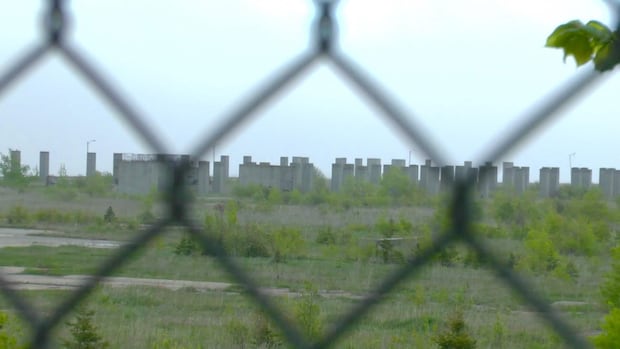Neighbour of P.E.I.'s abandoned bridge fabrication yard wants it cleaned up
After putting up with bridge construction 20 years ago, Read says it's time the yard was restored to farmland

George Read from Borden-Carleton, P.E.I., had a front-row seat for the biggest construction project in Prince Edward Island history — the billion-dollar Confederation Bridge — since his house was just steps from the bridge fabrication yard.
- A look inside the gates of the former Strait Crossing fabrication yard
- Confederation Bridge fabrication yard removal work could be done by summer
But the bridge just celebrated its 20-year anniversary, and Read is ready for the landscape to change.
"I kind of wish those cement blocks would go now, but I guess it's going to cost over a million dollars to get clear of them," said Read.
"Even if they put windmills up there so wind turbines would be something interesting except those cement blocks."
No firm plans
Today, the 82-year-old can still peer over the chain link fence that separates his back yard from the abandoned construction site that now looks like Stonehenge, with its dozens of concrete pillars.

Read was there from the start of the project in 1993 — watching as 60 hectares of land his father used to farm was transformed into a construction site, where the massive concrete sections of the bridge were made.
After the construction equipment and workers left, weeds soon took over the fabrication yard and graffiti artists left their work on the abandoned concrete pillars.
Although there has been lots of talk over the years about restoring the site, there are no firm plans yet.
Read hasn't asked anyone to clean up the site, though.
"That would be like talking to my dog," he laughed.
'Sad in a way'
"Well, it went from pasture land to a fabrication yard and it certainly it wasn't anything I grew up to," said Read of the changes back in 1993.

"It was sad in a way but being a necessity, fretting about it was not going to change anything, so I just rolled along with the flow."
During the four years of 24-hour-a-day construction, Read put up with a lot of dust and noise.
Fortunately he worked in another community during the day and when he came home in the evening he could hear a dull roar of machinery just 100 metres away, but said he got accustomed to it.
Finally, in May 1997, Read watched as fireworks heralded the opening of the Confederation Bridge that now links the Island to the mainland.
'A lot of history'
Read's house overlooking the Northumberland Strait has been in the family for generations.
"There's a lot of history in this house," he said.
"My grandfather was a sea captain and he was the first captain of the car ferries down here."
Life was good growing up on the 200-acre farm. "I really loved it here," said Read.
"I couldn't see myself living in a town with houses all crammed up together. Not all of us are fortunate to live in a big space like this."
'Quite content here'
But that space got a lot smaller when Read's brother sold most of his land to bridge developer Strait Crossing Development Inc. for its fabrication yard.
Read was left with three acres, and said no one from the company ever talked to him about buying his property.
"They didn't think I wanted to sell," said Read. "Somebody told them that they needn't bother come near me, 'cause I wouldn't sell."
At one time, Read said the company did offer to move his house.
"I said, 'No. I'm quite content here, as long as I can get in and out,' which I did."
- MORE P.E.I. NEWS I New school staffing numbers not what some parents hoped
- MORE P.E.I. NEWS I Island students take home 8 medals at Skills Canada competition


